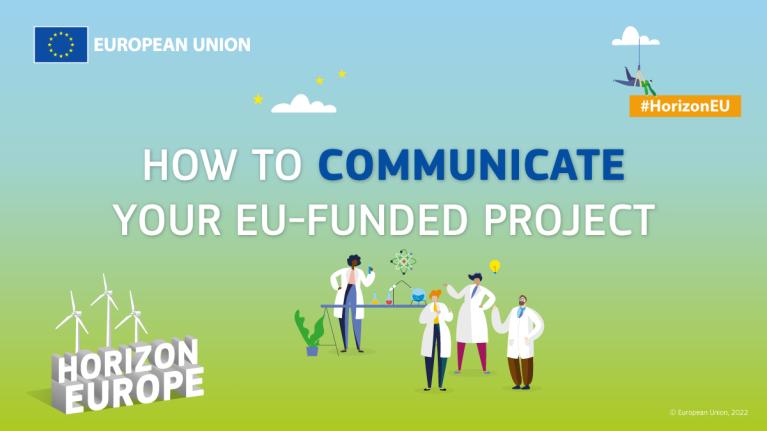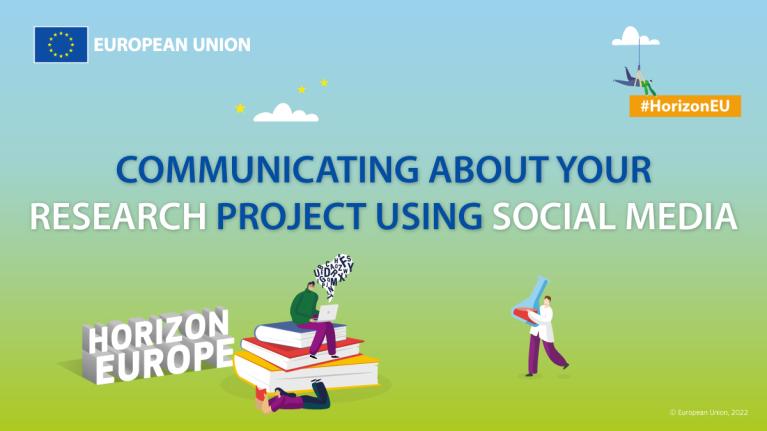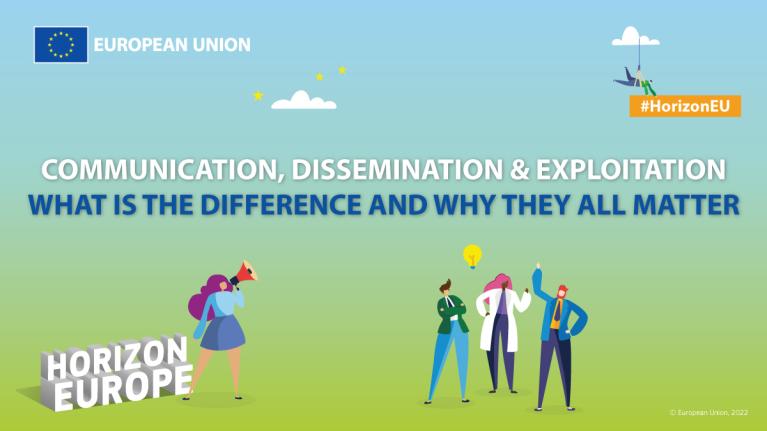Do you receive funding to carry out a project under Horizon Europe or any other EU programme? Then you should not forget to communicate about your project and its outcomes.
Making your EU-funded project visible is crucial to reach out to relevant stakeholders and build new collaborations. It is also a legal obligation under your grant agreement.
Read this page and find out why and how you should communicate about your work. We have also compiled all you need to know in a leaflet - check it out below.

- General publications
- 22 August 2022
Six reasons to communicate about your EU-funded project
Watch the video below that highlights the importance of communication.
How to communicate about your EU-funded project
Looking for tips? This video gives six top tips to enhance your visibility.
Social media
Social media is an effective and engaging tool that allows you to instantly communicate to your audiences at a low-cost. Check out our leaflet on social media below to get started and take your communication to the next level!

- General publications
- 19 September 2023
Social media is an effective tool that allows you to communicate about your research at low-cost. Find out how to make the most of this communication tool to enhance your project and its results.
The European Research Executive Agency (REA) has a Twitter/X and a LinkedIn account. All REA-managed projects are welcome to connect with us.
There is also a dedicated Twitter/X account on EU green research (dedicated to Horizon Europe Cluster 6 – Food, bio-economy, natural resources, agriculture and environment).
In an interview with two EU-funded research projects, we talked about the challenges and the opportunities of communicating about research using social media.
Being on social media does not replace the obligation of having a web presence. This can either be a dedicated website or integrated within a pre-existing one. This online presence should provide details about your project's objectives, actions, progress and results.
When using Social Media to communicate about your research project, try to think to:
- Display the EU flag
- Acknowledge EU funding, e.g.: This project is funded/co-funded by the European Union under @HorizonEU research and innovation programm.
- Add a disclaimer, e.g.: Any related tweets reflect only the views of the project.
Success stories
If your project has achieved outstanding results relevant to EU citizens, then it could be promoted via some of the European Commission’s free-of-charge channels such as:
- Research & innovation success stories
- Horizon Magazine
- Cordis Results in Brief
- CORDIScovery podcasts or
- during events such as the R&I Days or European Week of Regions and Cities.
Liaise with your REA Project Officer for further information.
Acknowledge EU funding
Obligations for recipients of EU funding programmes 2021-2027
Since 2021, all recipients of EU funds have the legal obligation to acknowledge that their action has received EU funding.
This requirement applies to all programmes, including Horizon Europe (Article 17), the Research Fund for Coal and Steel and the Promotion of Agricultural Products.
All beneficiaries, managing authorities and implementing partners have to display prominently the EU emblem and funding statement on all the communication materials, dissemination activities and any equipment, infrastructure, vehicle, supply or result financed by the grant.
How to display the EU emblem and funding statement


Make sure to display the European flag (official EU emblem), do not use the European Commission logo. Add the funding statement next to the official EU emblem (in local languages, where appropriate)
Actions or beneficiaries that receive 100% EU funding should use funding statement 1 – Funded by the European Union (even though there may be other ineligible costs for the action or other participants who bring their own resources and funding, such as the associated partners). Actions or beneficiaries that are not funded by the EU at a rate of 100% are considered co-funded and should use funding statement 2 – Co-funded by the European Union
Third-party funding (including associated partners from other national sources) can be acknowledged by displaying relevant logos next to the EU emblem (the principle of proportionality should be respected).
Support kit for EU visibility
- Operational guidelines for recipients of EU funding
- 10 tips on how to communicate and raise visibility about EU funding
- Download centre for EU emblem and the funding statement (for REA-managed projects only use of the two funding statements portrayed above)
- Online funding statement generator
Communication, dissemination and exploitation
Communication, dissemination and exploitation are interlinked concepts that are sometimes confused.
Check out our leaflet to learn what the difference between these concepts is and what European Commission tools are available to support your project.

- General publications
- 16 June 2023
More information is also available on the dedicated page on dissemination and exploitation.
How to comply with EU data protection rules
Did you know that data protection should be part of your communication activities?
No matter what activity we perform, we have the obligation to protect people’s fundamental right to privacy and their right to access, rectify or delete data collected about them. This has a legal basis, as personal data are protected under the EU General Data Protection Regulation (GDPR).
You may wish to use personal data in your communication, but there are some actions you can take to comply with data protection and protect people’s rights.
- Identify the communication activities or products (videos, photos, articles, events, etc.) for which you would use people’s personal data.
- List what data you will collect. Personal data is an encompassing term, meaning any information relating to an identified or identifiable natural person (such as names, emails, images, gender, etc.). This must be done even if they are your colleagues.
- Prepare a Data Protection Record for each specific communication activity (events, newsletters, videos, etc.) to describe how you are using the personal data (i.e. processing of data).
- Prepare a Data Protection Notice to inform people what data is being collected and for what end (e.g. a communication campaign, a video, and event, etc.).
- Prepare a consent form for the individual whose personal data you are seeking to process.
- Share with them the corresponding Data Protection Record and Data Protection Notice and the consent form. The individual(s) can physically sign the consent form and return it or provide consent by clearing stating that they agree to their data being processed in accordance with the DP Record and DP Notice in a written communication.
- Keep track of all your Data Protection Records, Notices and consent forms signed during the entire lifecycle of the project.
- Data must be stored for the shortest time possible and must be indicated in the DP Record and DP Notice. Establish the time limit to erase that data. As a reminder, you may want to add in your calendar when you should delete the data you have collected.
- Keep the personal data safe: take appropriate technical and organisational measures to ensure the security of personal data and take immediate action in case of complaints or breaches.
- Do not save images to your personal devices, nor re-use images from external sources, where people are recognisable. You cannot be sure they comply with data protection rules. The same applies to any personal data.
You may want to get inspired by our Public Central Register and the guidance/checklist get ready to comply with data protection rules.
You may also perform communication activities without collecting and processing people’s personal data. For example, taking and using photographs of an event without the attendees (i.e. photographs of the venue) or where they are not recognisable.
The information and guidance in these webpages are intended to contribute to a better understanding of EU data protection rules.
This is intended purely as a guidance tool – only the text of the General Data Protection Regulation (GDPR) has legal force. As a consequence, only the GDPR is liable to create rights and obligations for individuals. This guidance does not create any enforceable right or expectation.
The binding interpretation of EU legislation is the exclusive competence of the Court of Justice of the European Union. The views expressed in this guidance are without prejudice to the position that the Commission might take before the Court of Justice.
Neither the European Commission nor any person acting on behalf of the European Commission is responsible for the use which might be made of the following information.
As this guidance reflects the state of the art at the time of its drafting, it should be regarded as a 'living tool' open for improvement and its content may be subject to modifications without notice.

